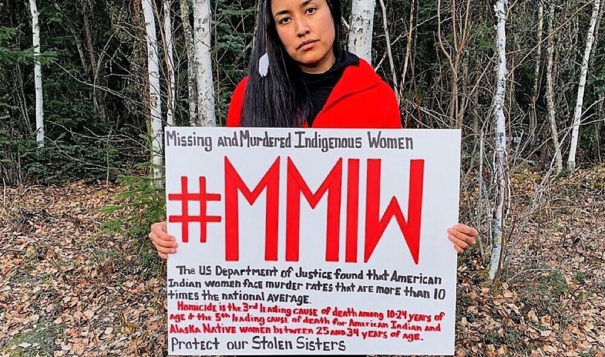News Article Article pages that do not meet specifications for other Trust Project Type of Work labels and also do not fit within the general news category.
Lawmakers launch South Dakota liaison office for missing, murdered Indigenous persons
 COURTESY / Native Women’s Wilderness
Native Women’s Wilderness: “By wearing red, we can call back the missing spirits of our women and children so we can lay them to rest."
COURTESY / Native Women’s Wilderness
Native Women’s Wilderness: “By wearing red, we can call back the missing spirits of our women and children so we can lay them to rest."
Legislators in South Dakota sent House Bill 1199 to Gov. Kristi Noem to create a liaison office to address the issue of murdered and missing Indigenous people. Noem’s aides commented that she’s sympathetic to the MMIP movement and likely to sign the bill into law.
The National Crime Information Center documented 5,712 known incidents of missing and murdered American Indian women in 2016. Along with the incidents, the National Institute of Justice says that 84 percent of all Native women have experienced violence in their lifetimes.
Historically, criminals have taken advantage of poor cohesiveness between federal, state, and tribal governments. On the tribal level alone, different government branches and agencies fail to work together efficiently.
“By no means is this the final solution to finding missing people, but this is a step towards filling the gaps of jurisdiction and finding a solution,” bill sponsor Rep. Peri Pourier told Buffalo’s Fire.
“By no means is this the final solution to finding missing people, but this is a step towards filling the gaps of jurisdiction and finding a solution.”
-bill sponsor Rep. Pourier
HB 1199, which was passed by the State House with 57-12 vote and the Senate with a 33-2 vote, would create a liaison office that would provide training and assist in locating missing Indigenous persons. All state agencies would cooperate with the Office of the Attorney General, undergo training and report to the MMIP office as required.
House Bill 1199 is very similar to the national bill Savanna’s Act, which 116th U.S. Congress made law in 2020. Savanna’s Act directs the U.S. Attorney General to develop law enforcement and justice protocols appropriate to address the issue of murdered and missing American Indians. The AG’s office develops protocols based on information gathered by different state agencies that helps clarify the delegation of responsibilities to state and tribal governments.
Savanna’s Act is named after Savanna LaFontaine-Greywind, a citizen of the Spirit Lake Tribe in North Dakota, was pregnant when she was murdered in 2017. The act had backing from MMIW advocates in Montana and is a part of a framework of federal and state legislation aimed to find missing persons.
The Not Invisible Act also passed in the 116th U.S. Congress. It created a commission that included members from tribal law enforcement, officers from the Bureau of Indian Affairs, state and local law enforcement officers from the areas close to Indian lands, and an official from the FBI. The commission coordinates grants and programs related to missing Indians.
Additionally, South Dakota approved SB 164 in 2019 to establish procedures for the investigation of certain missing and murdered Indigenous persons. It requires that the director of the Division of Criminal Investigation prepare and distribute guidelines and procedures for inquiries, establish a law enforcement training program for following these recommendations, and commence data collection to share with state, tribal and federal agencies.
“In various tribes, red is known to be the only color spirits see. It is hoped that by wearing red, we can call back the missing spirits of our women and children so we can lay them to rest.”
-Native Women’s Wilderness
These acts have created a network of rules and regulations in order to increase communication between agencies and protocols for finding missing persons. Buffalo’s Fire asked Rep. Pourier why she believes 1199 is important to the movement.
Pourier said that the locations of many of these incidents and their documentation are known factors. However, without a person to go through the data, nothing can be known for certain. HB 1199 would create an office responsible for sifting through the information.
The MMIW movement has been fighting to end the violence against Native women. On Nov. 4, 2019, they hung the Missing and Murdered Indigenous Women Quilt in the South Dakota State Capitol.
“In various tribes, red is known to be the only color spirits see,” according to Native Women’s Wilderness. “It is hoped that by wearing red, we can call back the missing spirits of our women and children so we can lay them to rest.”
Christian Hustad is an Assiniboine content creator; you can contact him at cjhustad.94@gmail.com.
